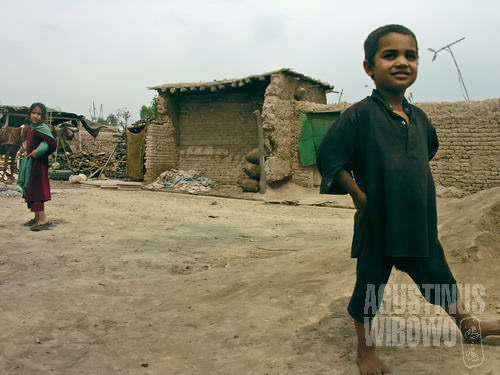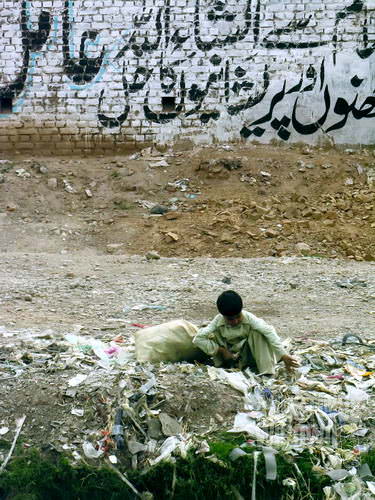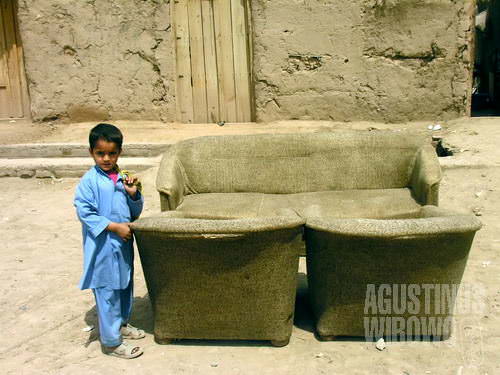Peshawar – Smuggler Bazaar
April 13, 2006

Refugees children
Karkhana Bazaar, or smuggler bazaar, was quite among the most famous time in Peshawar memorabilia, due to its proximity with its infamous border, Afghanistan. But the smuggler bazaar today is no more than row of shops selling daily needs. It was Friday anyway, so the shops were closed. And we were there to buy beauty cosmetics… sigh.
The bus we took to smuggler bazaar threw us away two kilometers before the place. But it was good. I had the chance to observe some children working along the river collecting garbage. The garbage collectors, mostly children in the Asia subcontinent, are among the most distinctive life of the grass root of the countries. The children, boys and girls, were happy with photographs. Some even posing with their meaningful garbage sack.

Many children end up as garbage pickers
Not far from there was the Afghan refugee’s camp. It was a very condensed shanty town, but now, the Pakistani government had given them the deadline and by force sent them home. There were 30,000 Pashtun refugees from Afghanistan, mostly from Jalalabad and surrounding. But now there were not more than 20,000 people. Still a lot. Their living condition brought me back to my memory in Afghanistan. Yellow coloured muddy brick houses in lines and rows, with small alleys like maze. Children were exited to see foreigners taking photographs. Suddenly we were surrounded by children, who, aggressively, asked to be photographed. Their hard condition pushed them to be though. They screamed “Hey! Hey!” and sometimes threw stones to attract attention.
Someone had stolen some stuff from Lam Li’s pocket. We were warned before to leave this area soon as the people might steal something from us. And it happened. The mob of children did distract even the most careful traveller. Luckily it was not an important thing, just her camera bag.

Afghan refugee in Kacha Garhi
It was Sher Shah who returned the stuff to Lam Li and escorted us to leave the area. He is a 22 refugee from Jalalabad, Afghanistan, and spoke English quite fluently. “I am jobless,” he said, which then led him to the grieving about the deadline of going home.
“We dont have anything there, no land, no house,” he said, “What we can do there? What we can do there?”
Repatriation, for these Afghan refugees, is dilemmatic. They had left their homeland for many years, in case of Sher, it was 20 years. He left the country when he was only two. He believed that the remainders of their family wealth there was almost to nil, after the war with Russia, Mujahiddin, and Taliban. The Pakistani government wanted to get rid of the refugees, but the refugees insisted to remain, or withdraw to the lawless Tribal Areas.
That day was Friday, the bazaar we were going to was almost completely closed. I have heard there should be really ‘smuggling’ stuff in this bazaar, instead of just the imported chinese soaps and shampoos, but we didnt have the luck to encounter any.

Soekarno Chowk/Square in Peshawar
On the way back, people were busy for Friday Prayer. It is a big deal in Pakistan. The mosques were overflown by people, that many of the people had to pray outside, on the main road, taking half space of the traffic. Cars passing by, but it didnt seem to interrupt their concentration in communicating with God.
We tried a Chinese restaurant nearby. It was lavishly decorated restaurant, with very strong Chinese atmosphere. It had been at least three months for both of us not to eat Chinese food, and somehow seeing a Chinese restaurant is like finding oasis in the middle of desert. We were excited that the food was quite original, and suspected that one of the cooks should be a Chinese. Chinese restaurants, without pork and chopsticks, are still recommended in Pakistan.
It was a treasure to find a history book about Indonesia’s darkest age in an old book shop. It was written by an ABC journalist, Michael Maher, who stayed in Indonesia for five years at the end of the regime Suharto. It was scary, eye-opening journalistic piece. First it showed the corrupt cleptoric Suharto feudal kingdom (Indonesia was called as Suharto kingdom), the surpressed media, but the fast economic growth. Then it moved to the frictions, to the anti-Chinese riots in many corners of the country, the scandals of the corrupt ministers, the surpression in Aceh Papua and East Timor, and at last the balcanization of the country. It was sad. It was tragic. The story about the Jakarta riot which also included the very famous email thread story about Vivian, an 18 year old girl who was raped during the riot. The last part of the book was talking about the reform, from the unrealistic Habiebie until the physically weak Aburrachman Wahid. The writing was very strong that I dreamt to return to Suharto era in my sleep.






Leave a comment